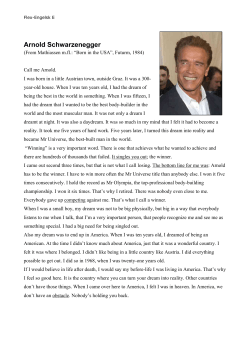
The American Dream then and now
Fact file 3 The American Dream then and now The term American Dream was first used by the historian James Truslow Adams in 1931 to explain what had attracted millions of people of all nations to settle in America. The concept itself is, of course, much older. The early settlers in America hoped for a better life than the one they had left behind in Europe. Their main reasons for leaving Europe were religious persecution, political oppression and poverty. They dreamt: • the personal dream of freedom, self-fulfilment, dignity and happiness, • the economic dream of prosperity and success, the dream of rising from poverty to fame and fortune i.e. from rags to riches, • the social dream of equality (of opportunity) and a classless society, • the religious dream of religious freedom in a “promised land” in which they were God’s chosen people, • the political dream of democracy. This American Dream is reflected in basic beliefs and values. In spite of America’s regional and cultural diversity, these give the nation its character and are still shared by most Americans today: – freedom Americans commonly regard their society as the freest and best in the world, superior to every other nation. They like to think of their country as a welcoming haven for those longing for individual freedom and opportunity. Americans’ understanding of freedom is shaped by the Founding Fathers’ belief that all people are equal and that the role of government is to protect each person’s unalienable rights, including freedom of speech, press and religion. – individualism In the early days, the success of most Americans depended on their ability to confront the hardships and challenges of the wilderness on their own. Today, the idealization of the self-reliant, self-sufficient, independent individual is still alive. Government regulation is often resisted, and it is seen as the individual’s responsibility to make a living and succeed in a competitive society. – mobility; optimism; flexibility The pragmatism of Americans and their belief in limitless resources is related to the American tradition of mobility. Settling the West (“going west”) meant making a fresh start in a land of spaciousness (geographical mobility). Today with the same sense of optimism about their chances to succeed, Americans are still prepared to move great distances to improve their lives through a better job or a more pleasant climate. They also accept a high degree of social mobility (upward and downward) on the “ladder of success” © Ernst Klett Verlag GmbH, Stuttgart 2006 | www.klett.de Von dieser Druckvorlage ist die Vervielfältigung für den eigenen Unterrichtsgebrauch gestattet. Die Kopiergebühren sind abgegolten. Alle Rechte vorbehalten. as a fact of life, and relate this success primarily to individual achievement and their own flexibility when looking for new opportunities. – hard work According to the Puritan work ethic, it was the individual’s duty to work hard and to show self-discipline. Material success through hard work was seen as a sign of God’s favour and a good education as the key to prosperity. – progress From the very beginning, the belief in progress – and the desire to progress personally by making use of opportunities – has been very important to Americans. On a different level, Americans argue that the nation’s progress is reflected in its growing prosperity, economic strength and political power. Americans have always regarded themselves as a nation with a mission. Settling the West in the 19th century for example was seen as the nation’s “Manifest Destiny” i.e. a manifestation of God’s will that his chosen people spread divine principles. In international terms, Americans tend to see themselves as playing a similar role, i.e. spreading democracy and the Western way of life across the world, and claiming to make progress in this field as well. – patriotism: Foreign visitors to America are quick to observe numerous patriotic symbols. American flags are omnipresent, and stickers announce “I’m proud to be an American”. National holidays such as Thanksgiving and Independence Day (4th of July) intensify the sense of national pride. Historical landmarks of the American Dream 1776: The Declaration of Independence, as the legal foundation of the American Dream, states that “all men are created equal” and that every citizen has “a right to life, liberty and the pursuit of happiness”, thus reinforcing the importance of equal opportunities, freedom and self-realisation. 1789: The Constitution establishes the principles of democratic government. 1791: The Bill of Rights restricts the powers of the central, federal government and reinforces the freedom and equality of all American citizens. 1790-1890: After the Revolutionary War (1776-1783) Americans start to move westward and to settle the vast North American continent. The furthest point of white settlement set up by American pioneer families becomes known as the “frontier”. Surviving in solitude and tough conditions requires the so-called frontier spirit, i.e. a strong Sicher ins Abitur ISBN-10: 3-12-547186-9 ISBN-13: 978-3-12-547186-3 1 Fact file sense of self-reliance and pragmatism. In 1890, this great historic movement westward finishes with the end of the Indian wars. The historically unique existence of a huge, thinly populated area of free and mostly fertile land, its gradual recession and the advance of civilisation are essential to the American character. 1865: Slavery is legally abolished at the end of the Civil War, under the presidency of Abraham Lincoln. 1869: Full voting rights are given to women in the state of Wyoming. Not until 1920 do all American women get the right to vote. 1870: Voting rights are extended to all adult males of all races. 1933: Franklin D. Roosevelt aims to overcome the extreme poverty and inequalities that resulted from the Great Depression of the 1920s. His legislation includes work creation programmes, direct relief to the unemployed and a basic national system of social security. 1964: As a result of Martin Luther King’s Civil Rights Movement and his dream of a colour-blind society, racial segregation in public places, schools, etc. and job discrimination are banned. Legal discrimination is hereby abolished. 1960s/1970s: The younger generation of Americans increasingly rejects the traditional values of their parents and the government. They follow their own dream of individual freedom and the pursuit of pleasure. The American Dream today Critics see the American Dream as a clever political and economic marketing strategy. They want people to get away from selfish individualism and materialism, and to return to community spirit and social responsibility. The huge gap between the rich and the poor in America is obvious, but at the same time the role of state welfare and political intervention in helping weaker members of society remains controversial. “Affirmative action”, however, is a widely practised policy of supporting blacks and single parents, especially in education and work schemes. © Ernst Klett Verlag GmbH, Stuttgart 2006 | www.klett.de Von dieser Druckvorlage ist die Vervielfältigung für den eigenen Unterrichtsgebrauch gestattet. Die Kopiergebühren sind abgegolten. Alle Rechte vorbehalten. 3 In social terms, the concept of a classless society has never really become reality because of the existence of an underclass of people who refuse to join the “rat race” of a competitive, success-oriented society. This lower class sees mainstream America as an uncaring dog-eat-dog society, and themselves as losers in the race for success. In a society marked by a huge diversity in income and lifestyles, the middle class often works long hours, taking on several jobs with hardly any holidays in order to be able to live the American way. The rich enjoy the benefits of material success. In ethnic terms, the various minority groups cope differently with the pressure on the individual in a society which is marked by the ambition to succeed. The Native American population (two per cent of the population) has, to a large extent, never fully adapted to the white lifestyle and system of values. The African-American minority (twelve per cent) has split into a small prosperous black middle class and an impoverished underclass. A rapidly growing Hispanic community (13 per cent) largely consists of MexicanAmericans who have illegally immigrated and are often exploited as cheap workers on farms and in private households. A small but growing Asian-American community (five per cent) is mainly made up of academically educated, highly qualified, ambitious professionals who earn a salary far above the national average. The vision of America as a “melting pot of nations” (cf. the Latin motto “e pluribus unum” – one from many – which still today appears on all American coins), in which the foreign immigrants give up their national identity, way of life, culture and language and form a new nation, has never become reality. In the 1960s, the growing self-confidence of the minorities, their fight against discrimination, and the influx of new ethnic groups who refused to be culturally absorbed by American society, has made America look for a new image for this concept. The concept of the “salad bowl” was suggested as more accurate, accepting America as diverse, multi-cultural and pluralistic. Sicher ins Abitur ISBN-10: 3-12-547186-9 ISBN-13: 978-3-12-547186-3 2
© Copyright 2025





















